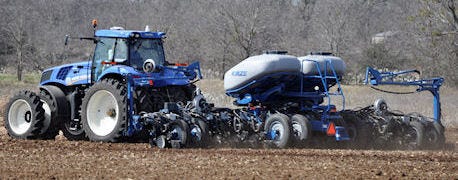
"We're excited to not only be a lead partner in this new technology, but to bring Midwest farmers the opportunity to utilize the multi-hybrid corn planting system on their own farms," Scott Beck, vice president of Beck's Hybrids, says about the company's latest ag tech venture.
"As a seed company, it is our goal to bring farmers quality, high-performing products for their acres. We are also committed to evaluating new technologies to increase yields and profitability," he says.

TAKE CONCEPT TO NEXT LEVEL: Two years of multi-hybrid planting trials proved that this was technology worth continuing.
Spring of 2013 brought even more significant changes to improve multi-hybrid planting. While this research was still in the beginning stages, developing management zones in fields was an important step to increasing yields and practicing sustainable farming.
The second year of multi-hybrid planting on Beck's Practical Farm Research Farms allowed for improvements. The addition of auto-correcting with the GPS-based AB lines allowed the tractor to shift slightly to the left or the right as the hybrids changed, therefore keeping both hybrids in a single row.
Related: Ag Technology and Innovation Take Planting to the Next Level
Response time between hybrids would also be updated, providing as little overlapping of seeds as possible without leaving a blank spot.
Using GPS yield monitor data, soil maps and slope analysis over an entire field, a detailed map of the field can be set up in management zones and a variable rate multi-hybrid prescription can be up-loaded to the on-board computer system.
Beck's also added a second multi-hybrid planter to their research. A 16-row Kinze 3600 planter was adjusted to accommodate two hybrids being planted in the same field. Front units were shifted and hydraulic motors were added for changing seed varieties on the fly.
Each of these first two years of trials proved to show positive results in increasing yields. Fall of 2012 yields were increased by an average of 17.3 bushels per acre in high productivity yield zones and 6.8 bu/a in low productivity yield zones. Fall of 2013 showed that yields were increased by an average of 5.0 bu/a in low productivity yield zones and 4.2 bu/a in high productivity zones.
This provided two years of consecutive data that indicated positive returns for multi-hybrid planting.
Spring of 2014 brings even more advancements to this new technology that is beginning to prove its value. Spring is already here in Texas. Planting began in February, and a new prototype Kinze planter was first tested there.
Kinze notes that they are testing a concept in a pilot program. The company has not announced a potential commercial release date, nor made a promise to manufacture and offer multi-hybrid planters.
About the Author(s)
You May Also Like




